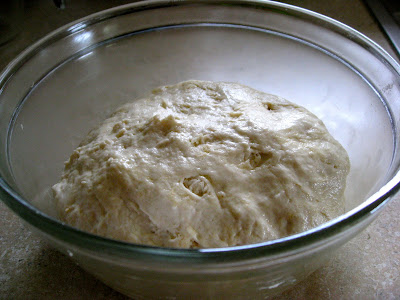 |
| White pizza with asparagus and red peppers. |
Did you notice the Sourdough Files up at the top navigation bar? I will add some basic sourdough how-to soon, and that is also where I'll post links to the sourdough recipes I share. I also want to try creating my very own whole wheat sourdough starter from scratch (most sourdough starter is born from an already existing starter). So, keep watch for that... I'm sure you can hardly wait. Meanwhile, feast your eyes on this:
 |
| Starter straight from the fridge. |
 |
| Stirred, measured, happy. |
Mix in 1/2 c. warm water, then 2-3 c. flour. I used unbleached, white, but whole-wheat would be good, too. No exact measurements here because every starter is different, and you have to go by feel: as soon as it starts to come away from the sides of the bowl, turn it out onto the counter and knead by hand. Add a little flour if you need to, but you want a pretty sticky dough.
Oiling your hands with about a tsp. of olive oil works better than flouring them, since the dough needs to be sticky and not over-floured. Then, let it rest for a couple of hours, or all day if you want to. More of that "sour" sourdough flavor develops, the longer you let it sit out.
I cover mine loosely with oiled plastic wrap and put it in the microwave or un-heated oven. You can leave the light on for a little extra warmth, which will help the yeast.
 |
| A few hours later; dough is risen and gluten is relaxed. |
 |
| White pizza. |
Oil & Herb Pizza "Sauce":
2-3 Tbsp. olive oil
1-2 cloves garlic, pressed (amount depends on your love of garlic)
2 tsp. chopped fresh basil
1/2 tsp. chopped fresh oregano
Mix together and spread with hands over your crust.
Top with a light coating of shredded mozzarella. I do love cheese, but with this kind of pizza, less is more. I used thin stalked asparagus, which I first brushed with oil, sliced red bell pepper and yellow onion. (I wish I'd had some black olives on hand.) Then a grating of fresh parmesan and a sprinkling of pepper to top it off:
Bake at 400 degrees for about 15 minutes. If you used all of the dough for a thicker crust, it will need to bake for at least 5 minutes longer.



No comments:
Post a Comment